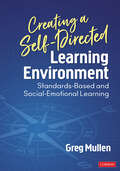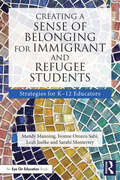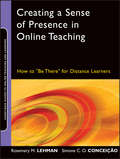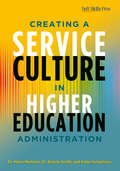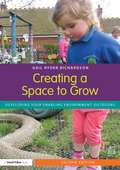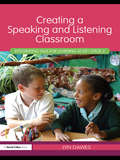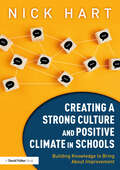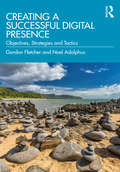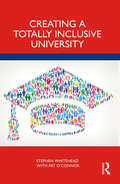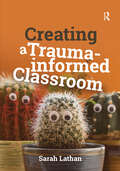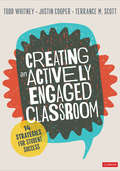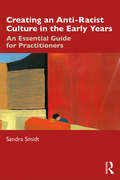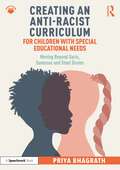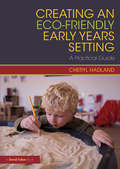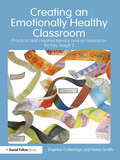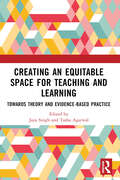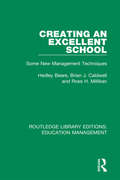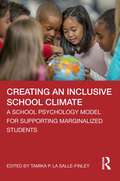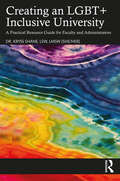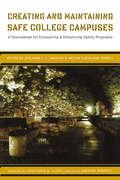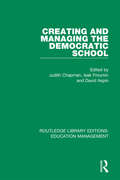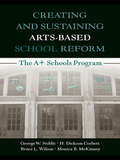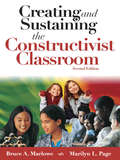- Table View
- List View
Creating a Self-Directed Learning Environment: Standards-Based and Social-Emotional Learning
by Greg MullenEducate the whole child—improve the whole school. Implementing new teaching practices can feel like juggling. This book shows you how to balance standards-based learning, social-emotional learning, and cognitive development and build realistic plans for success. With a flexible, three-tiered, visual framework designed for schoolwide collaboration, it helps you build on your school&’s strengths and the potential of existing programs. It also offers: • An integrated philosophy focused on self-directed learning and the whole child • Attention to academic inclusion, behavior intervention, and classroom management • Research sourced from CASEL and state programs and initiatives • Numerous illustrations, tables, and graphics • Tools and supplemental resources for implementation
Creating a Self-Directed Learning Environment: Standards-Based and Social-Emotional Learning
by Greg MullenEducate the whole child—improve the whole school. Implementing new teaching practices can feel like juggling. This book shows you how to balance standards-based learning, social-emotional learning, and cognitive development and build realistic plans for success. With a flexible, three-tiered, visual framework designed for schoolwide collaboration, it helps you build on your school&’s strengths and the potential of existing programs. It also offers: • An integrated philosophy focused on self-directed learning and the whole child • Attention to academic inclusion, behavior intervention, and classroom management • Research sourced from CASEL and state programs and initiatives • Numerous illustrations, tables, and graphics • Tools and supplemental resources for implementation
Creating a Sense of Belonging for Immigrant and Refugee Students: Strategies for K-12 Educators
by Mandy Manning Ivonne Orozco Sahi Leah Juelke Sarahí MonterreyDiscover how to create a sense of belonging and connection for your immigrant and refugee students. This timely book, written by four award-winning teachers, offers compelling stories and practical applications to help you reach your students in the classroom and beyond. Topics covered include advocacy, using literacy to create a welcoming environment, connecting with families, building staff capacity and best practices for virtual learning. You’ll also find easy-to-implement lesson plans, as well as reflection questions throughout to help you on your journey. Appropriate for K-12 teachers, English Learner specialists and school leaders, this inspiring and useful book will help you make the necessary changes to create more positive outcomes for your immigrant students.
Creating a Sense of Presence in Online Teaching
by Rosemary M. Lehman Simone C. ConceiçãoHow can faculty create a strong e presence for their online classes? This volume highlights the need for creating a presence in the online environment. The authors explore the emotional, psychological, and social aspects from both the instructor and student perspective. It provides an instructional design framework and shows how a strong presence contributes to effective teaching and learning. Filled with illustrative examples and based on research and experience, the book contains methods, case scenarios, and activities for creating, maintaining, and evaluating presence throughout the cycle of an online course.
Creating a Service Culture in Higher Education Administration
by Mario C. Martinez Brandy Smith Katie HumphreysService delivery is part and parcel of every higher education professional’s job, both to improve service to students and to each other as “internal customers”. Until now higher education professionals have had to rely, for their professional development, on books and training designed for the business sector. This book is the first to specifically address the needs of higher education professionals across a wide range of administrative functions within college and university environments. It is designed for administrative staff and management, ranging from professionals working in centralized functions such as student affairs and enrollment management to those working as advisors or in career centers, whether in community colleges, four-year institutions, or for-profit institutions.Each chapter applies customer service principles to scenarios that are relevant to higher education. The book begins by engaging the reader to define service and identify the external and internal customers who are recipients of that service. It then maps customer interactions into a series of steps and offers departments and individuals a tool to maximize the customer experience. Additional chapters address customer expectations, creating a service culture on your campus, and managerial influences on staff service delivery. Creating a Service Culture in Higher Education Administration is a complementary book to the online customer service and management training resources at softskillspros.com.
Creating a Space to Grow: Developing your enabling environment outdoors
by Gail Ryder RichardsonIs your outdoor area working? Do you want to make changes but are not sure where to start?Creating a Space to Grow guides you through the process of changing and developing the outdoor environment of your early years setting to maximise the learning potential that these areas can offer. Packed full of strategies and ideas for enhancing outdoor area
Creating a Speaking and Listening Classroom: Integrating Talk for Learning at Key Stage 2
by Lyn DawesProviding children with opportunities to talk about their learning enables teachers to hear what children are thinking. Talking with one another allows children to question, elaborate, and reflect on a range of ideas. Classroom talk can be motivating and involving, and helps children to think and learn. And yet it is difficult to organise such talk in a classroom. Children unaware of the importance of talk for learning may think of talk as ‘just chat’ – and learning falls away as they slip into social talk. This book provides teachers with strategies and resources to enable whole classes to work together through the medium of talk. Creating a Speaking and Listening Classroom provides timely professional development for teachers. Based on a theoretical approach underpinned by classroom research, this book offers classroom-tested strategies for engaging children in their own learning. Such strategies involve the direct teaching of speaking and listening. Activities in the book can ensure that children know how and why to support one another’s learning in whole-class and group work. The approach enables teachers to ensure that personalised learning programs are based on what children already think and know. The suggested strategies for teaching speaking and listening can enable children to use one another’s minds as a rich resource. This stimulating book will be of interest to professionals in primary education, literacy co-ordinators, and trainee primary teachers.
Creating a Strong Culture and Positive Climate in Schools: Building Knowledge to Bring About Improvement
by Nick HartIf there is one thing that school leaders need to get right, it is school culture. When they do, children learn more and colleagues have a stronger sense of purpose - they are more motivated and ultimately more fulfilled. Creating a strong culture and a positive climate requires an understanding of the complexity of school life and this begins by building knowledge. This book supports leaders to do just that. Drawing on ideas from different domains, this insightful book reveals the role of concepts such as autonomy and trust in school improvement. Each chapter sets out the specific knowledge and expertise required by school leaders for great cultural leadership and offers practical examples and case studies to show how they can be applied in different school contexts. Creating a Strong Culture and Positive Climate in Schools is an essential lens through which to examine the common problems faced by school leaders. It is invaluable reading for all those wanting to become more expert in school leadership and to better solve the everyday problems that arise from leading a school.
Creating a Successful Digital Presence: Objectives, Strategies and Tactics
by Gordon Fletcher Noel AdolphusIncreasingly graduates, and anyone who is entering employment, need an individual digital presence to stand out and showcase themselves to secure their first professional role. This book takes an employability approach to encourage those currently studying, or about to enter the world of work, to develop a set of skills that enables them to recognise and deliver an effective digital presence, firstly for themselves and then for the organisations who would employ them. It does not assume any prior technical knowledge and emphasises the value and benefits of creating a presence to actively participate in the digital economy. By structuring the chapters incrementally, the reader is guided through the development of their own presence while also being given the concepts and tools that will enable them in the future to scale this activity to suit the needs of a startup, an SME or a social business. By using well-established business principles to design a strategy, the reader is guided through the creation of a personal Theory of Change that will enable them to turn an abstract goal into an individual digital presence through a defined series of stages and intermediate change objectives. The book then proposes a series of tactics to draw out concrete actions. A range of examples and case studies from around the world feature in each chapter to showcase the range of different types of digital presence that can be created. By using a strategic and systematic process, this book draws together academic thinking with tangible and highly practical outcomes. It is essential reading for advanced undergraduate and postgraduate students studying any discipline related to the digital world, particularly digital marketing and digital business, entrepreneurship and strategy, as well as those taking employability and personal professional development programmes.
Creating a Totally Inclusive University
by Pat O'Connor Stephen WhiteheadThis book introduces the concept and practices of Total Inclusivity to universities around the world. It is written to help universities contend with increasing public scrutiny and uncertainty around issues of diversity, equity, inclusion and justice now at the forefront of global higher education. Providing a guide and template to higher education leaders, the book addresses such issues as work culture, free speech, student wellbeing, racism, LGBT+ identities, managerialism or ‘simply’ the ability of the institution to survive post-Covid. Whitehead and O’Connor argue that handling these issues can best be done in a university climate and system which is Totally Inclusive. This is the standard for any higher education institution to aim for, not only in its teaching but in its fundamental principles and everyday practices if it is to meet its obligations to its members and to wider society. The book aims to support universities as well as challenge the status quo as they grapple with the different global and societal pressures confronting them. It is an essential read for anyone working in leadership in higher education institutions and those interested in creating inclusive practices within their institution.
Creating a Trauma-informed Classroom (Critical Teaching)
by Sarah LathanA game-changing toolkit for teachers, empowering them to build their understanding of adverse childhood experiences (ACEs) and to develop their trauma-informed teaching practice.There is now a greater understanding on the impact of our early experiences on our stress response system and how this affects children in the classroom. Based on research and real-world experiences, Creating a Trauma-informed Classroom equips teachers of both primary and secondary phases to create compassionate and trauma-sensitive learning environments by suggesting and explaining up to date and practical strategies.An experienced ASN teacher who uses these strategies in her daily practice, Sarah Latham focuses on: how to build and maintain positive relationships with pupils affected by trauma and ACEs how to create a supportive environment how to design and deliver learning how to work collaboratively with others and how to promote emotional regulation in the classroom, including supporting dysregulated and distressed behaviours. Each chapter summarises key points from literature, research, and policy to provide a concise and accessible text without data and jargon overload. Pupil voice is also highlighted through reflections and opinions from children and young people, and case studies from different schools and projects across Scotland that have developed new approaches to trauma-informed practice.A perfect resource for an teacher or senior leader wishing to create a trauma-informed school.
Creating an Actively Engaged Classroom: 14 Strategies for Student Success
by Terrance M. Scott Todd Whitney Justin T. CooperMake your lessons interesting, interactive, and engaging Successful lessons are explicit, yet also inspire active learning and opportunities to respond. As the one shaping lessons, can you do better? Probably, and you’re not alone. Research shows teachers consistently offer students far fewer than the recommended opportunities to respond, leaving all students—including those with special needs and behavior challenges—less than engaged and falling short of their best chance for success. With this book, you’ll discover 14 strategies you can translate directly to your classroom, complete with descriptions, advantages and disadvantages of each, and how and when best to use them. Divided into three parts, you will be guided through Verbal engagement strategies, such as whip around, choral responding, quick polls, and individual questioning Non-verbal engagement strategies, such as stop and jot, guided notes, response cards, and hand signals Partner and teaming strategies, such as turn & talk, cued retell, four corners, and classroom mingle Dive into these strategies and transform your classroom into a rich and interactive environment—no matter the subject, context, or age of your students.
Creating an Actively Engaged Classroom: 14 Strategies for Student Success
by Terrance M. Scott Todd Whitney Justin T. CooperMake your lessons interesting, interactive, and engaging Successful lessons are explicit, yet also inspire active learning and opportunities to respond. As the one shaping lessons, can you do better? Probably, and you’re not alone. Research shows teachers consistently offer students far fewer than the recommended opportunities to respond, leaving all students—including those with special needs and behavior challenges—less than engaged and falling short of their best chance for success. With this book, you’ll discover 14 strategies you can translate directly to your classroom, complete with descriptions, advantages and disadvantages of each, and how and when best to use them. Divided into three parts, you will be guided through Verbal engagement strategies, such as whip around, choral responding, quick polls, and individual questioning Non-verbal engagement strategies, such as stop and jot, guided notes, response cards, and hand signals Partner and teaming strategies, such as turn & talk, cued retell, four corners, and classroom mingle Dive into these strategies and transform your classroom into a rich and interactive environment—no matter the subject, context, or age of your students.
Creating an Anti-Racist Culture in the Early Years: An Essential Guide for Practitioners
by Sandra SmidtAt a time of growing evidence of racism across many countries and cultures, Creating an Anti-Racist Culture in the Early Years will help those working with young children recognise racism, name it for what it is and help their young pupils understand that difference is nothing to be feared. Drawing on both personal research and established theory, Smidt includes examples of anti-racist practice from real life and in literature, looks at how racism is acquired and cites examples of people who have spoken or acted against racism through the centuries. She emphasises how and why it is essential to develop multicultural education into anti-racist education and why it’s so important to go beyond the mere celebration of differences in cultures. This indispensable resource also addresses: What racism is and why it is so corrosive How to recognise and challenge it in an early years setting How to work with parents and carers to help them reassess their prejudices or unconscious bias How to create an anti-racist curriculum and culture through inclusion, multiculturalism, literature, art and drama. Creating an Anti-Racist Culture in the Early Years is an indispensable resource for all early years practitioners and students of early childhood education who believe in creating more equitable opportunities for all of our young children.
Creating an Anti-Racist Curriculum for Children with Special Educational Needs: Moving Beyond Saris, Samosas and Steel Drums
by Priya BhagrathThis thought-provoking and experience-led book guides teachers and leaders to create anti-racist practices and to develop a curriculum for children with SEND, promoting cultural representation and giving all pupils a voice and a sense of belonging.Informative and practical chapters challenge the reader to review their whole school system and policies, taking them on a step-by-step journey through three main parts. The book enables educators to understand how this work can be meaningfully applied when working with SEND pupils and families in all settings, with topics covered including: exploring what an anti-racist curriculum is and why it’s needed for pupils with SEND establishing buy-in from school staff and meaningful support from key stakeholders creating an action plan and establishing accountability providing opportunities for high-quality CPD for all stakeholders how to create a cultural calendar and curriculum offer of representation developing whole school practices to link to home and the community preparing pupils for life beyond school. Pupils with SEND can access complicated topics if the subject matter is presented in a way that makes sense to them, with purpose, clarity and relevance to their lives. This book provides essential content and guidance for professionals to follow and implement for the benefit of SEND pupils and will be key reading for educators working in mainstream education, additional resource provisions, SMEH provisions and special schools.
Creating an Eco-Friendly Early Years Setting: A Practical Guide
by Cheryl HadlandThis book offers a comprehensive guide to becoming a more eco-friendly setting, from small steps that can be taken to reduce waste and improve efficiency to setting up partnerships. It illustrates how sustainable choices can become a natural part of every child’s education and how children, parents and staff can all inspire sustainable behaviour across local communities and at national and international levels. Covering all aspects of practice including colleague and parental engagement, the environment, routines, resources, and teaching and learning, the book helps readers and practitioners to embed a sustainable approach in day-to-day practice. It draws on recent research, studies and stories of success and failure that can be adapted to fit everyone’s own journey towards a more sustainable world. The chapters address topics such as: plastics and their alternatives sustainable food sustainable resourcing transport and trips waste management. Drawing on the experiences of real nurseries and including a wide range of activities and lists of resources, this is an essential read for practitioners, leaders, policymakers and all settings that want to help make sustainable choices a natural part of young children’s lives.
Creating an Emotionally Healthy Classroom: Practical and Creative Literacy and Art Resources for Key Stage 2
by Daphne Gutteridge Vivien SmithThis practical resource book for Key Stage 2 explores a range of emotions using both original poetry and well-known artworks to stimulate discussion in the classroom. Based on the extensive teaching experience of Daphne Gutteridge and Vivien Smith as well as current educational initiatives such as ECM and SEAL, this book is aimed at practitioners who are committed to creating an emotionally healthy classroom environment where children feel valued and confident about managing and responding to feelings. Providing practical and creative resources throughout, this book: Covers both negative and positive emotions, including confidence, hope, resilience, excitement, disappointment, sadness, frustration, confusion and many more Links to SEAL initiatives and the PHSE curriculum Has activities for all abilities Outlines clear objectives and resource lists for all activities Essential reading for all teachers who wish to create an emotionally literate environment, this book provides a practical and creative resource to enable teachers to develop emotional literacy in a cross curricula context in their classrooms.
Creating an Equitable Space for Teaching and Learning: Towards Theory and Evidence-based Practice
by Jaya Singh Tasha AgarwalThis book discusses the issues of equity-based education in India and advocates for providing fair and inclusive system of education. It focuses on the practice of democratic education to promote critical thinking and develop problem-solving attitudes among learners in learner-centric classrooms. Offering insightful comments on the contemporary issues related to Education in India, the book underlines the need for teachers to draw from the reforms suggested in the New Education Policy 2020 to ensure equitable learning. It aims to develop teachers’ capacity to identify students’ needs and ensure community participation. The book discusses a range of topics such as holistic assessment, reflexive pedagogy, ICT, innovations in education, and inclusiveness among others. While providing theoretical as well as empirical insights on the approaches needed in classrooms for better learning, it also provides anecdotal evidence and case studies to support equity-based education. The book will be of interest to teachers and researchers of education, vocational education, and teacher education. It will also be useful for educators, educationists, education administrators, Special educators, academicians, policymakers, in-service teachers, teacher educators and teacher trainees.
Creating an Excellent School: Some New Management Techniques (Routledge Library Editions: Education Management)
by Brian J. Caldwell Hedley Beare Ross H. MillikanOriginally published in 1989. The pursuit of excellence is much discussed with reference to education, but the question remains, ’How can a school become excellent?’ This book demonstrates that excellence depends on good management which, in turn, depends not only on a clear understanding of good management theory, but on the ability to translate theory into practice. The authors offer profound insights into three crucial areas of leadership: culture, structure, and public accountability. Drawing on areas outside education, such as advertising and business, they discuss many innovations that are already current - flexitime, the vertical curriculum, mastery learning, community support - and depict ways in which these can be brought together into a total educational experience. More strikingly, however, they look ahead, examining the potential changes to our concept of schooling: for instance those brought about by the growth of information technology. This book emphasises that at the heart of outstanding schooling are visionary leadership, a clear sense of purpose, and creatively conceived and flexible support structures.
Creating an Inclusive School Climate: A School Psychology Model for Supporting Marginalized Students
by Tamika P. La Salle-FinleyCreating an Inclusive School Climate introduces school psychology stakeholders to a wealth of foundations, individualized experiences, and school improvement efforts intended to bolster the outcomes of our most vulnerable learners. As student populations grow increasingly diverse, sociocultural variables have never been more important to supporting school climate. Using an original cultural-ecological framework, this book builds on the experiences of historically underrepresented and oppressed youth to foster a socially just, strengths-based perspective for implementing school improvement efforts within multi-tiered systems. Faculty, graduate students, researchers, and professionals in the field will come away with a conceptually and methodologically sound understanding of the interrelationships between personal characteristics, culture, ecological contexts, and school climate.
Creating an LGBT+ Inclusive University: A Practical Resource Guide for Faculty and Administrators
by Kryss ShaneThe rates of bullying and dropouts due to lack of safety in colleges and universities and subsequent suicidality for LGBT+ young adults and college students are exponentially higher than for non-LGBT+ people. As a result, many American college students are suffering needlessly, and many faculty and administrators are unsure of what to do. This book solves that problem. Setting out best practices and professional guidance for creating LGBT+ inclusive learning in schools, this approachable and easy-to-follow book guides faculty, administrators, and other staff toward appropriate and proven ways to create safer learning environments, update campus policies, enhance curricula, and better support LGBT+ college students as they learn.
Creating and Maintaining Safe College Campuses: A Sourcebook for Enhancing and Evaluating Safety Programs
by Jerlando F. L. Jackson Melvin Cleveland TerrellThis book serves as a sourcebook to enhance and evaluate safety programs, generate new solutions and interventions, comply with new legislation, and present practical steps and guidelines to establish best practices. It pays particular attention to the factors that may give rise to crime, considering high-risk drinking and examining the intersection between hate crimes and violence. Devoting chapters to discrimination in all its forms, whether against international students, students of color, or on the basis of ethnicity or sexual orientation, it reviews the range of issues relating to harassment and violence against women and engages with hazing and the presence of guns on campus. The authors pay attention to the different circumstances that may apply in specific institutional types, such as community colleges and minority-serving institutions. They offer perspectives from administrators, campus security, student affairs personnel, faculty and policy makers.The purpose is to provide readers with the context and tools to devise a comprehensive safety plan. For administrators operating with few formal support systems, advice is given on how to co-opt individuals and resources from around the campus and the local community to assist in maintaining a safe and welcoming campus.Click here for press release.
Creating and Managing the Democratic School (Routledge Library Editions: Education Management #4)
by Isak Froumin Judith Chapman David AspinOriginally published in 1995. In securing the future of any democracy, it is vital that the education service should provide an effective introduction to citizenship by means of a high quality and empowering curriculum in educational institutions organized and administered according to democratic principles. In this volume, educators with a variety of backgrounds and experience gained in educational institutions in both Russia and western countries address the question of the conception, justification and implementation of the idea of 'education for democracy'. This is the first publication to emerge from a collaboration of Russian and Western educators in recent times and is an enthralling account of education in countries with wide social, political and historical differences yet having common ground to share over the creation and management of their school systems.
Creating and Sustaining Arts-Based School Reform: The A+ Schools Program
by George W. Noblit H. Dickson Corbett Bruce L. Wilson Monica B. McKinneyTaking a close look at the issue of the arts and school reform, this book explores in detail how the incorporation of the arts into the identity of a school can be key to its resilience. Based on the A+ School Program, an arts-based school reform effort, it is much more than a report of a single case - this landmark study is a comprehensive, longitudinal analysis of arts in education initiatives that discusses the political, fiscal, and curricular implications inherent in taking the arts seriously. Offering a model for implementation as well as evaluation that can be widely adapted in other schools and school districts, this book will inspire arts educators to move from advocating more arts to advocating the arts as a way to reform schools. Administrators and policy makers will see how curriculum integration can be used to revitalize and energize schools and serve as a springboard to wider reform initiatives. Researchers and students across the fields of arts education, school reform, organizational change, and foundations of education will be informed and enlightened by this real-world scenario of large-scale school reform.
Creating and Sustaining the Constructivist Classroom
by Bruce A. Marlowe Marilyn L. PageUpdated Edition of Bestseller!Marlowe and Page bring together constructivist theory with step-by-step guidance and ready-to-use checklists to make constructivist learning a reality in your classroom.
